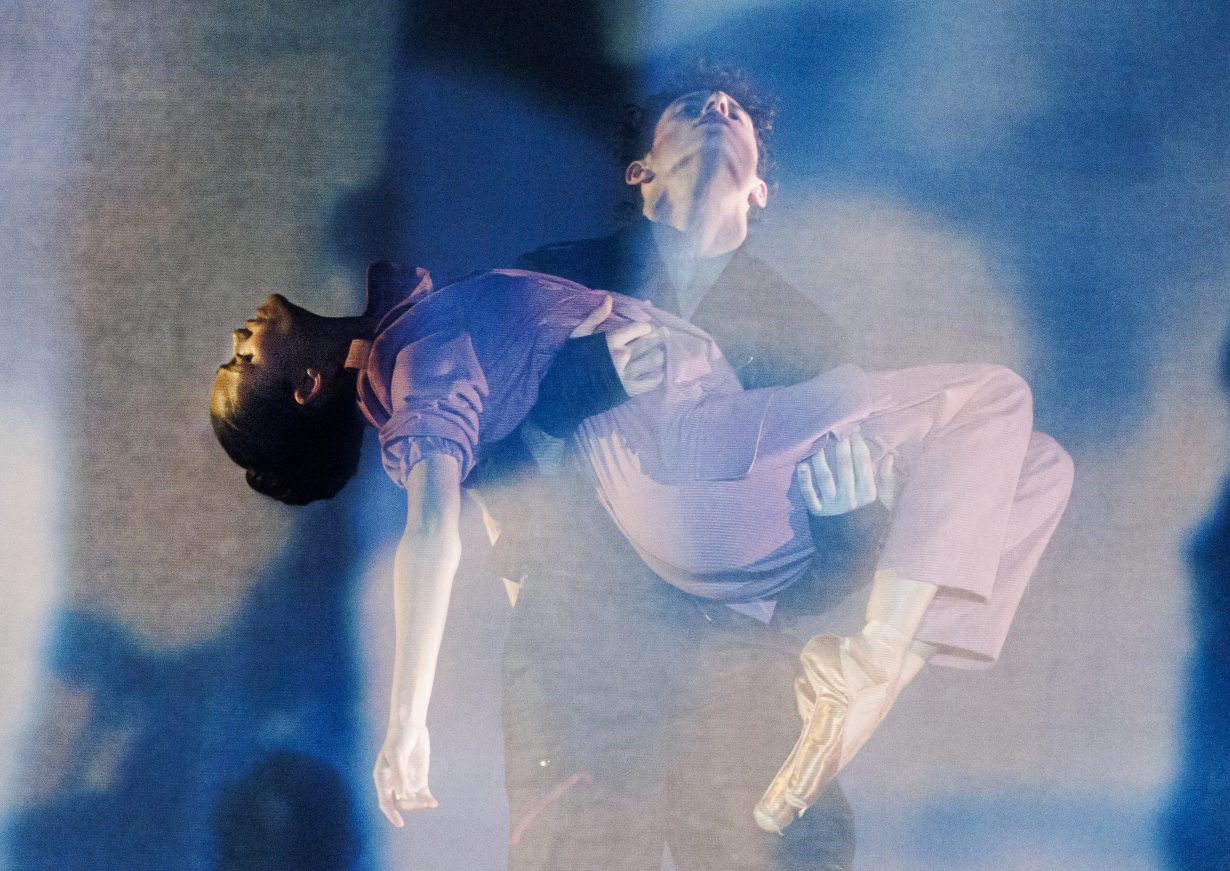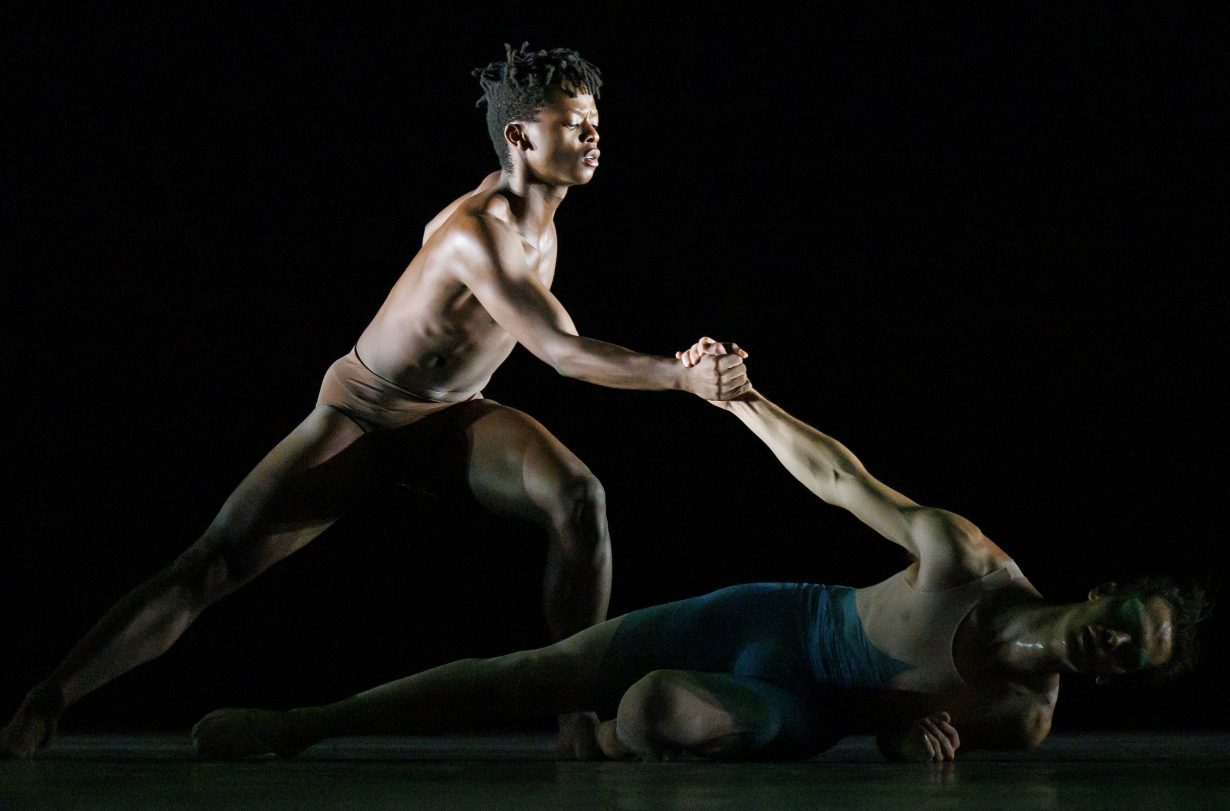Wayne McGregor’s adaptation of a Margaret Atwood science fiction trilogy proves that mangled-remake culture knows no limits
This is where the world ends: a rave in London’s Royal Opera House, all flashing lights, bopping angular bodies and thumping electronic music. Towards the end of the second act of MADDADDAM – choreographer Wayne McGregor’s flashy ballet adaptation of Margaret Atwood’s Oryx & Crake trilogy (2003-13) of post-apocalyptic science fiction novels, with a score by cool-classical composer Max Richter – we are finally shown what unleashed a pandemic responsible for wiping out most of humanity. Every one of the lithe ravers has lined up to take a pill; one minute they’re giving it socks, the next they’re all dead. A small tower onstage with a LED screen broadcasts the imagery of this apocalypse, of a blue, diamond-shaped pill, that looks like Viagra, going up in flames.
Atwood’s not-too-distant future is one of genetic engineering gone wrong, where humans have bred chickens without beaks or eyes that can grow twelve drumsticks each, and created pigs with human genes, ‘pigoons’, to facilitate organ transplants. One self-appointed genius scientist, Crake, also figures humans should be gotten rid of to make way for a new species of glowing childlike creatures he has engineered with coral skeletons and jellyfish-green eyes, referred to as the Children of Crake. The trilogy follows the handful of people who have survived his chemical cull, as they remember their past lives while navigating between packs of murderous (human) thugs and herds of wild, ravenous pigoons.

There is of course much more to each of the books and their total thousand-odd pages; but that’s not relevant to this skipping blender of a ballet. McGregor’s future is a quick, not unentertaining, two hours that attempts (and fails) to condense all three books into a dance narrative, making full use of layered video projections, light-up screens and a bit of puppetry to augment his dancers. A long-planned production that first was staged by the National Ballet of Canada in 2022, and is on McGregor’s home turf (as resident choreographer of the Royal Ballet for almost 20 years) for a brief eight-show run, MADDADDAM has five main characters it juggles between, three narrators (including an offstage robot-child; an unseen woman’s voice, presenting scenes as if they were part of a nature documentary; and a scruffy man, meant to embody a hippyish eco-warrior, who at one point gives a list of demands); one act styled as a time-hopping video game, and more non sequiturs than you could shake an elongated, human-pig hoof at. It includes, at one point, cannibalistic fur-vest toting gangs having a West Side Story style dance-off. There’s a love triangle – one of the survivors, Crake’s friend Jimmy, was in love with Crake’s girlfriend Oryx – and many the central set pieces are of their elegant to-ing and fro-ing, of lustful intertwining and anguished on-pointe separation; at least twice the men enact their complicated relationship by tossing the petite woman between them.
It’s perhaps saying something that the same stage that will soon be holding Puccini’s Tosca and Cinderella was host to this dress-rehearsal for human extinction, as a bid for currency and cultural relevance. McGregor, Richter and Atwood combined should easily rise to the challenge, each having been marked innovators in their respective fields in the late 90s and early 2000s, though there are points during the production where you’re left wondering exactly whose apocalypse they’re depicting. There are some clunky attempts at hammering home the contemporary-ness of the adaptation, with the poisoned party pills being handed out under a yellow cross and a sign that reads ‘PHARMA’, while Jimmy wears what looks like a worn out MAGA hat. And perhaps the notion of erectile dysfunction pills on fire is particularly distressing for a certain demographic? It feels like a more generational statement when most of the stage time is dedicated to memories of the past rather than the transformations of its present, that the story as its packaged here is concerned less with actual survival and more with legacy.

Popular culture is currently dominated by a swollen, cannibalistic glut of adaptations and remakes – films and TV shows made from books, comics, or just recycling old films, from Wicked, Paddington, Venom, or Shogun, to Atwood’s own Handmaid’s Tale. How an adaptation makes use of its source is just as important as what it’s adapting, particularly as what is becoming recycled is ever more retrogressive; it used to be every era has its Hamlet, now each era has its Hulk. Is a novel about a mutant apocalypse really the right thing to adapt for the strict body and gender regimens of the ballet? How do pert bums and all this lady-lifting narrate our collective failure as humanity? The potency of science fiction and its future projections is its implication of the present; but the disaster presented in MADDADDAM feels frictionless and smoothly inevitable, if not almost celebratory. We might blame only the aloof tech-bro styled Crake for attempting to engineer the planet’s fate, it seems to suggest, with no attempt to ask the audience to consider their own role in how such a damned future came about.
Herds of pigoons (dancers donning bulbous, cycloptic masks and long, hairy front limbs) drift through the stage occasionally, but mainly it all revolves around the humans and their romantic concerns. Absent are any of the other mutant creatures from Atwood’s books they might have had fun putting into dance: skittering bioluminescent rabbits, rakunks, lumbering wolvogs, slinking snats and bobkittens as other wayward genetic experiments that have escaped and bred in the wild, mostly human-less world. It might be unfair to try and play pin the tail on the pigoon in comparing what’s missing from McGregor’s ballet to its source material. In fact, the weaknesses here often emerge from the production’s attempts to hew too closely to the books’ many characters and their fragmented subplots, where no storyline ever feels fully established or explored before we’re swept onto the next set piece, with the production still attempting to do character introductions well into the second act. And who might blame McGregor for overdoing it, after feasting on such flesh; Atwood herself has a tendency to Star Wars her own stories, adding unnecessary sequels and grouting imaginative gaps where none were needed, with the Testaments following the Handmaid’s Tale, and the Oryx and Crake trilogy being two books too many.

And yet: the third act opens wordlessly, a flock of the Children of Crake in gold and blue bodysuits circling onto the stage. They cycle in swirls, entering with heads ducked and elbows cocked awkwardly upwards, as if birds about to take flight. They become a murmuration of jostling bodies, their erratic mass reminiscent of the head-bobbing and stretched limbs of a colony of seagulls or, even more unlikely, a flamboyance of flamingos comes to mind. Here, the mutant possibilities of human dance finally find some expression, and here McGregor’s adaptation finally trusts itself to tell its own story.
Ultimately, MADDADDAM retreats again, with the human dancers returning for what feels like an overly conciliatory ending (humans always try to make the story about themselves), but McGregor’s half-born translation of the story into a new form, and the potential for what the production could have been, is itself instructive. The deluge of adaptations and endless regurgitations is only reflective of a wider apocalypse to come. Our future crisis is one of ideas, a paucity requiring a willingness to depart from existing narratives. Mangled remakes aren’t going to save us; but maybe there’s some hope in mutant forms.
